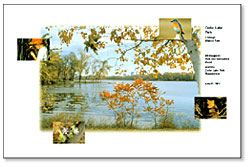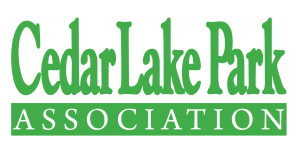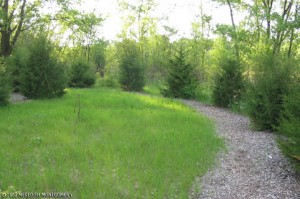Vision for the Land
In 1988, neighbors joined together to save from development a large parcel of land on the north and east sides of Cedar Lake in Minneapolis. Seeking out and inviting all interested parties to participate, the group focused on a vision—to establish a nature park in the heart of the city–and adopted a set of organizational principles.
This marked the beginning of the Cedar Lake Park Association. In time, the group raised over a million dollars in private funds, bought the land that is now Cedar Lake Park, and built the award-winning Cedar Lake Regional Trail.
Following the design principles and concept master plan developed in partnership with the Minneapolis Park and Recreation Board, we’ve made outstanding progress. Trails extend from the park to all parts of the city.
Thousands of native grasses, wildflowers, shrubs and trees have been planted. Reclamation projects are restoring the landscape and providing new habitat for wildlife. Chipped paths and water pumps have been installed for humans.
All this is within walking distance of downtown Minneapolis! Fist-time park visitors return again and again to have their own experience in this natural world.
A four-point mission statement and our love for the park continue to guide us. This is a volunteer effort. Come to the park. Join us in nurturing nature.

Cedar Lake Park is a place to preserve, nurture, and sustain through the next century and beyond. Moreover, it is a fitting place where the greater urban community can invest its attention, efforts, and resources in learning how cities can exist and flourish while in harmony with nature.
Natural History
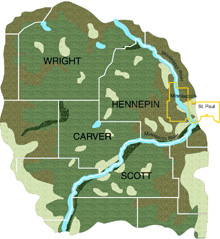
Natural History
Lands & Waters (see page 23, CLP Master Plan)
Ecology (see pages 26-33, CLP Master Plan)
Restoration and Reclamation (see pages 12-13, CLP Master Plan; Projects in the Park; Index to CLP Update articles)
Story of the Park
Creation of Cedar Lake Park
BY NEIL TREMBLEY, TREASURER & BRIAN WILLETTE, CO-FOUNDER, CLPA
[This article was first published in the Summer/Fall issue of the CLPA Update.]
Saving Cedar Lake Park
The creation of Cedar Lake Park is one of the more amazing stories in the history of Minneapolis, a story of ordinary people doing the extraordinary.
Starting in 1989, a group of citizens took on a daunting task: creating a nature park in the middle of the city. Along the way, they envisioned how a trail, running along the edge of this park, could spur the growth of an interconnected trail system throughout the metro area.
How did this happen?
Cedar Lake, just west of downtown Minneapolis, is situated within the banks of an ancient riverbed that eventually became the Minneapolis Chain of Lakes.
Until about 1980, the huge railroad yards that dominated the north and east sides of Cedar Lake ceased operations. In the mid-1980s, the railroads began pulling up hundreds of iron rails that criss-crossed the flatlands between the base of the Bryn Mawr bluff and the northern shoreline of Cedar Lake.
With the tracks gone, nature re-asserted itself. Weeds and grasses spread, squirrels and foxes took up residence and people began to make paths through the new prairie. Meanwhile, the railroad company made plans to sell the land to developers. In 1989, a huge sign went up advertising the developer’s vision of Cedar Lake Park: a few large, expensive homes close to the lake.
At the same time, a group of spirited citizens embraced a very different vision for this area. They sensed a unique opportunity to take this vacant land and help it blossom into a beautiful nature park, with a meandering trail gracing its edge. They saw that this trail could form the lynchpin connecting the Chain of Lakes to the west with the Mississippi to the east. They dreamed of a series of these greenways connecting the city and the suburbs. And they began the task of turning their dreams into reality.
They called this dream “Save Cedar Lake Park.”
But how do you save a park?
First, they decided to name and claim the land. They put out trashcans and put up signs proclaiming the area “Cedar Lake Park.” They talked to people passing through the park, promoting the idea of nature. They acted as stewards for this, the newest natural wonder of Minneapolis. Though they did not own the land, they claimed it for one and all.
As they began to organize, these citizens started to publicize their cause of public stewardship of the land. For many of them, the land had become a place for reflection, for experiencing nature, a spiritual place and a cherished space to bring friends and family. Their goal was to protect this area, and share the experience.
So they began to beat the drum for community support. With their bold and compelling idea, they went door to door, handing out leaflets with a straightforward message: What is the best use of this land? Which alternative do you want: big homes for a few, or a nature park for all?
Almost all the people contacted heartily endorsed the vision of a nature park with connecting trails. Buoyed by community support, this group of citizens decided to back up their message with some muscle and began a fundraising drive to raise one third of the cost of purchasing the land.
Of course, they had their doubters. When these bright-eyed political rookies came to a meeting to talk about their dream, a city council member at that time said, “This meeting is about development, not about building a park.” The railroad dismissed their efforts, thinking these well-meaning folk would soon tire of all the work needed to change the way it has always been done. Other powers saw this grassroots movement as nothing short of revolutionary–this was not the usual way the park process worked! Through it all, the Save Cedar Lake Park group persevered.
How did they do it?
First of all, they were inclusive. Anyone could join Save Cedar Lake Park. There was (and still is) no membership fee. All that was needed was a desire to support the process.
Another important characteristic was a positive approach. They weren’t against development; they were for a nature park. Houses—even big, expensive ones—weren’t bad; a nature park was better. Again and again, they drove home their forward- looking message as they asked, “What is the best use of this land?”
Critical to the decision-making process was working by consensus. The devil is in the details, it was often heard, so the group sought to focus on the key issue of saving the land, while not getting bogged down in minutia.
Most importantly, they were historians and visionaries. They looked at the park system created in Minneapolis 100 years ago and asked, “What would we like to see the city like 100 years from now? How can we begin the process of transforming our metropolitan area back to a more natural setting? And how do we create a dialogue in which quality of life in the urban environment is a primary concern?”
Enthusiastically they shared their vision and doggedly they pushed their agenda, winning over their fellow citizens. Then they initiated a dialogue that, over time, turned into a partnership with the Minneapolis Parks and Recreation Board (MPRB) to secure the land and create a park with trails. The City and Metropolitan Councils also entered the partnership to develop the connecting trails. And since the park would become part of the Chain of Lakes Regional Park, the state legislature was approached to join the partnership.
Lo and behold, in 1991, with determination, humor, and sweat equity, $600,000 raised from the community. With money from the state, the land was purchased from the railroad to become an integral part of the Minneapolis Parks system.
After accomplishing the seemingly impossible, this citizens group could now rest on its laurels, for the original plan had been to dissolve. Their agenda was to ensure the purchase of the land, make it a part of the park system and then close up shop. Too often a group starts out with the best of intentions, then evolves into an institution that no longer serves the purpose for which it was created. Not this group. Or so they thought.
For some, the park had become their touchstone. Their stewardship was not over. They needed to “Nurture Nature” for their vision to come to complete fruition. A multitude of issues beckoned to them: what type of park was it to be, should there be trails through it, should there be lighting in it, and what about parking? Rightfully, in the crusade to establish the park, the original group had postponed addressing these issues. Now, these concerns came to the front. Many simply could not walk away from the next critical stage in the life of the park.
They settled down to work. Re-naming themselves the Cedar Lake Park Association (CLPA), they continued their partnership with the MPRB, the new owner of the land, and the city’s Department of Public Works, for they had the vision and would provide the muscle to create a city-wide trail system.
In 1992, the Park Board created the Cedar Lake Park and Trails Citizens Advisory Committee with the president of the CLPA at its head. The committee first oversaw the creation of a plan for the construction of the Cedar Lake Trail that was consistent with the vision of the CLPA. They then created a Statement of Philosophy and Design Principles by which the park could be established.
Briefly, the statement encompassed the following objectives:
- Protect and improve the water resources and soils.
- Reconstitute a variety of native plant communities that reflect lake, wetland, prairie, Savannah, woodland and forest eco systems.
- Manage the plant and animal communities for long-term integrity, stability and beauty.
- Connect ecosystems, green corridors and trail systems.
- Minimize human artifacts and amenities within the conservancy.
- Integrate the surrounding land uses to complement the park.
- Facilitate learning experiences in the park.
- Celebrate people living in harmony with nature and each other.
Meanwhile, the CLPA had not been idle. Working with the MPRB, they created a comprehensive document called the Cedar Lake Park Master Plan. This bold declaration encompasses the totality of the park: where it came from, what it is, and what it should become.
Starting with the geology of the land, the document places the area historically and geographically. With the land in its present state, it outlines what type of flora should be planted, what type of wildlife supported and what kind of human interaction encouraged and discouraged. It provides a framework for educational activity and community service in the park. It is meant to be a living document (to be altered as needed) and is one of the great successes of the group.
For four long years, from 1991 to 1995, the group worked together to construct a vision of the park for the near future. They produced a newsletter three times a year to keep the membership informed about issues concerning the park. During these years, the nuts-and-bolts decisions were made. The seeds of careful planning were sown. And oh, the impatience to see them grow!
Then, in 1995, construction of Phase One of the Cedar Lake Trail was completed, and the prairie area just north of Cedar Lake was seeded. Two years later, the first memorial trees were ceremonially planted, creating the Cedar Grove. About that same time, funding was acquired to create a maple/basswood forest around the northeast edge of the lake. Other trees and shrubs were planted in subsequent phases of this project.
In 1998, the first memorial wildflowers were sown in the prairie. Since then, over 3,000 have been planted in and around the park. The nurturing of nature has proceeded, always within the framework of CLPA’s Master Plan.
Over the last five years, all of the original members of the Save Cedar Lake Park Committee have left active leadership. As one member put it, “It’s like a train ride. Some people get on the train and ride a short time; others ride a long time. However long they ride, when they see their station, they know it’s time get off.”
A new generation of leaders has taken over, guided by the principles and actions of those original visionaries. These leaders look back to what’s been laid out, and forward to what’s to be accomplished. As the group moves forward, CLPA’s founding principles of inclusiveness, consensus and partnership provide the energy and spirit needed to face the challenges with a positive spirit.
You may have noticed that no person has been named in this article. The primary reason is this: the Cedar Lake Park story is not about one or two people; it’s about a group of ordinary citizens who achieve extraordinary goals. Although none of the original members are still active in leadership roles, the group continues to thrive as it did in the beginning. Why? Because today’s members see clearly that as the action of the group corresponds to the vision of the group, the spirit of the group lives on.
Now, as we continue to “Nurture Nature,” we invite you to hop on board the train and help us take the next steps in realizing the dream of Cedar Lake Park
Vision, Design and Construction of the Park and Trail
Overall Vision
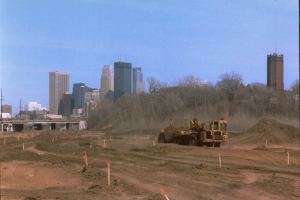 The vision for what has become Cedar Lake Park emerged during a consensus-driven process that allowed the community to discuss and debate ideas about the highest and best use of the land. This vision is described in detail in the Cedar Lake Park Concept Master Plan, a document produced by the Cedar Lake Park Association and The Minneapolis Park and Recreation Board (MPRB).
The vision for what has become Cedar Lake Park emerged during a consensus-driven process that allowed the community to discuss and debate ideas about the highest and best use of the land. This vision is described in detail in the Cedar Lake Park Concept Master Plan, a document produced by the Cedar Lake Park Association and The Minneapolis Park and Recreation Board (MPRB).
The Concept Master Plan was composed with input from numerous sources, includingJones & Jones Architects and Landscape Architects, Ltd. (see below), Balmori Associates, and local experts in wildlife biology and ecology planning. With their assistance, a citizen’s advisory committee crafted a set of design principles and a vision for each landscape unit of the park. The Concept Master Plan was published in June 1997 and accepted by MPRB shortly thereafter.
This page will eventually include more documents and photos about the vision, design, and construction of the park. Many of the citizens, businesses, and governmental entities that contributed to the park’s development are acknowledged in the Concept Master Plan. The park exists today because of their generous donation of time, money, and expertise.
Design and Construction of the Trail
The design and development of the award-winning Cedar Lake Regional Trail was executed by Jones & Jones Architects and Landscape Architects, Ltd., of Seattle, Washington. The Jones & Jones team included Grant Jones, Mario Campos, and Steve Durrant, along with consultants Richard Haag and Darrell Morrison. The firm was selected by the citizen’s advisory committee in a design competition among several firms. The trail project, supervised by the City of Minneapolis with involvement by the Minneapolis Park and Recreation Board (MPRB), was funded with federal transportation monies and private funds. Jones and Jones has been recently recognized for its influence on the professional practice of landscape architecture over a sustained period.
Memorial Cedar Grove
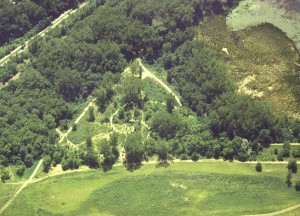
The spirals in the Heart of the Park area. Note the memorial cedar trees located along each spiral. Each tree was individually purchased to honor a special person and to raise money for the park. Also visible in this photo are the summer solstice sunrise line and the runic calendar, as well as the secondary bike/walk cinder trails that describe a pyramid enclosing the center of the spirals.
CLP Master Plan
Cedar Lake Park Concept Master Plan
This is a PDF version of the entire Master Plan completed by the Cedar Lake Park Association in 1995.
The Master Plan describes the philosophy and design of the park as well as the process by which many neighborhoods, organizations and individual volunteers worked together to make the park a reality.
The Plan also contains photos, descriptions of flora and fauna in the park and maps of the park’s trails.
